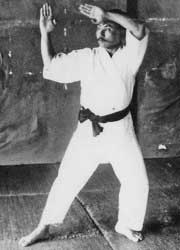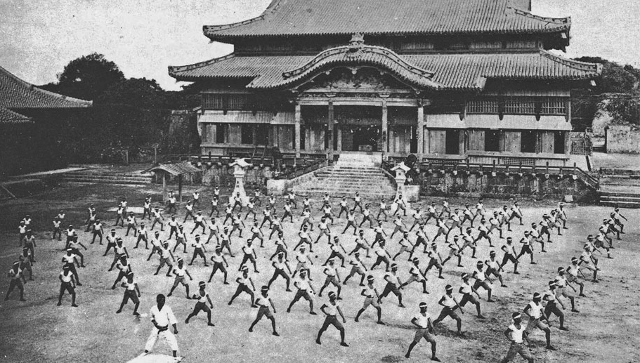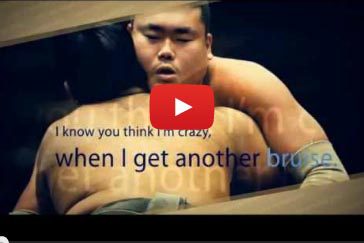Do you practice Heian/Pinan kata?
 If you train a popular style like Shotokan, Shito-ryu or Shorin-ryu – you probably do.
If you train a popular style like Shotokan, Shito-ryu or Shorin-ryu – you probably do.
Some Korean martial arts also practice them!
In fact, the five Heian/Pinan kata are some of the most commonly taught kata in the world of Karate.
But, here’s the weird thing…
Even though these kata are so common, few people know the REAL meaning and purpose of them!
It’s like a hidden secret.
I’ll explain.
But first, you must meet the mastermind behind it all:
Itosu Anko – The Genius of Heian/Pinan
The Heian/Pinan kata were created by a man named Itosu Anko.
Itosu was born in Okinawa in 1831, as a weak and shy child.

Because of this, he started practicing Karate to strengthen his mind and body.
Luckily, Itosu found one of the greatest masters in Okinawa to be his head sensei – Bushi Matsumura Sokon – a legend in the history of Karate.
(Related reading: Discovering The Lost Secret of Matsumura’s Mysterious Bo Staff)
Now, fast forward a few years.
In 1891, the Japanese army had expressed interest in making Okinawan Karate an official Japanese military martial art, since they were so impressed by the physical condition of several Okinawan conscripts during their medical examinations there.
However, the Japanese army quickly lost interest in Karate when they realized its outdated training methods, poor organization, lack of standardization and the great length of time it took to gain proficiency in it.
(Unsurprisingly, old-school Karate training could not serve the needs of the 6-8 week boot camp training which the Japanese military demanded.)
Itosu Anko heard these news…
…and decided somebody needed to modernize Karate!
The old ways of teaching simply didn’t appeal to modern society anymore.
Therefore, he developed a series of five kata, called “Pinan” 1-5.
Note: Although Itosu named these kata “Pinan”, they were later renamed “Heian” by Funakoshi Gichin (student of Itosu and founder of Shotokan Karate), during the introduction of Karate to mainland Japan, in order to suit the Japanese language.
(Related reading: The 9 Lost Throws of Funakoshi Gichin: Karate’s Forgotten Takedown Techniques)
The aim of these five Heian/Pinan kata was simple:
To reorganize the previously haphazard introduction of Karate for beginners, while simplifying the transition to advanced Okinawan Karate kata – like Naihanchin, Kusanku, Seisan, Wanshu, Gojushiho, Passai etc.
The idea was equal parts genius and bravery.
Because, with these new kata, Itosu could do something nobody had done before…
In 1901, he started teaching Karate at the Shuri Jinjo Elementary School.

The Okinawan people were shocked!
Karate was a secret and deadly martial art – not suited for kids in public school.
But, they didn’t know Itosu had a masterplan.
The Heian/Pinan kata system acted as a Trojan horse, allowing Itosu to bring Karate from its secretive darkness into the light of modernization.
Itosu’s plan worked so well, in 1905 he was allowed to teach at the First Junior Prefectural High School and later at the Okinawa’s Teachers College too.
(Related reading: 2 Forgotten (But Deadly) Techniques of Okinawan Karate)
The rest, as they say, is history.
Itosu’s campaign culminated in Karate becoming part of the official physical education of Okinawa’s school system, eventually making its way to mainland Japan – giving rise to school/university clubs, tournaments, mass teaching methods, ranks/belts, new styles, organizations etc – and later the rest of the world.
So…
If it wasn’t for Itosu Anko, perhaps none of us would practice Karate today!
Now, let’s look more closely at the actual meaning of Heian/Pinan kata.
(Hint: It’s NOT what you think.)
The Secret Meaning of Heian/Pinan
I love mysteries.

And the Heian/Pinan kata are a big mystery for many.
In this case, I’m not strictly talking about the bunkai (defensive application of kata movements), although those are tricky too.
I’m actually talking about the name!
Most people think the name “Heian/Pinan” translates to “Peace and Tranquility”, “Tranquil Mind” or something spiritual, very beautiful, Asian and zen-like.
That’s cool.
(I used to think so too.)
Until one day, when I discovered that the name Heian/Pinan could be interpreted another way…
You see, when I lived in Okinawa, I heard that Chinese culture is very admired there.
Seriously.
If something comes from China, it’s considered highly sophisticated in Okinawan society – especially the martial arts.
(Related reading: 10 Differences Between Okinawan Karate & Japanese Karate)
Since Itosu Anko was a true Okinawan scholar, he must have admired Chinese culture highly too, right?
So…
What if Heian/Pinan is not Japanese… but Chinese?
I decided to start a Karate Nerd™ investigation!
To find out, I sent an e-mail to a Chinese friend of mine, where I simply wrote the kanji (Japanese ideograms) for Heian/Pinan, and said nothing about its meaning in modern Karate (the commonly accepted “Peace and Tranquility” or “Tranquil Mind”).
The next day, his e-mail came back…
Check it out:
“Hi Jesse. Oh, that’s nothing special. We pronounce it “Pingan”, and it’s a pretty common word in China. It’s hard to translate exactly, but it means something like “stay safe” or “be protected from danger”. For example, when I flew back to China last summer, my family said it to me at the airport. It’s like a “stay safe” wish.“
BOOM!
My Karate Nerd™ sense didn’t fail me.
Heian/Pinan has NOTHING to do with esoteric “peaceful/tranquil mind” flower-power zen hipster mumbo-jumbo gibberish spiritualism.
Oh no.
Heian/Pinan is a personal “stay safe” message from master Itosu Anko, written in Chinese to honor the ancestral roots of Okinawan Karate, wishing you a safe journey in your quest for Karate mastery.
Wow!
(I got goose bumps from writing that. So cool!)
This, ladies and gentlemen, is the secret message of Heian/Pinan kata – hidden in plain sight – and only revealed to those willing to search for Karate’s forgotten roots.
If you want to follow Itosu’s footsteps, share this wisdom with the world!
Because there’s nothing “tranquil” about the Heian/Pinan kata.
It’s about using them to stay safe, in your journey through Karate – and life.
When used correctly, they will protect you.
But only if you study them deeply.
Those who seek shall find…



83 Comments